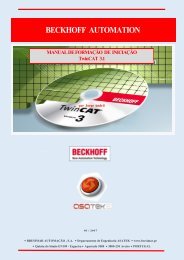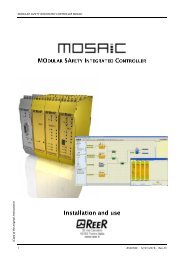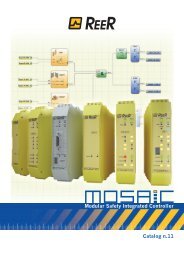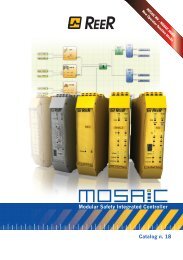BB ELECTRONICS CATALOG (2010)
Catalog from B&B Electronis (2010)
Catalog from B&B Electronis (2010)
Create successful ePaper yourself
Turn your PDF publications into a flip-book with our unique Google optimized e-Paper software.
Data Acquisition – Analog and Digital Remote I/O<br />
Temperature: Temperature inputs come in two variations,<br />
Resistance Temperature Detector (RTD) or Thermocouple.<br />
RTD: Simply put, an RTD is sensor used to measure temperature by<br />
correlating an elements resistance with temperature. RTD elements<br />
consist of a length of fine wire coiled around a ceramic or glass core.<br />
The wire is made of a pure material with a defined resistance.<br />
Platinum is the most popular and accurate. Copper is also used in<br />
some instances. A Pt100 sensor has a resistance of 100 ohms at 0°C<br />
and is by far the most common type of RTD sensor. A Pt1000 has<br />
1000 ohms resistance at 0°C. Copper RTD’s are usually built at 10<br />
ohms (CU10). Because of this low resistance, measured temperatures<br />
spans must be large to get an adequate signal. Therefore, CU10 RTD<br />
use is limited to devices such as motors or transformers.<br />
2-Wire RTD - The lowest cost method is to keep the signal<br />
conditioner close enough to the sensor so the copper wire<br />
resistance change does not introduce an excessive error in the<br />
measurement.<br />
3-Wire RTD - Lead compensation with 3 wires requires 2<br />
conductors attached to one end of the RTD and a single conductor<br />
on the other end. This method requires the 3 lead wires to track<br />
each other in resistance change versus ambient temperature. It is<br />
effective for a total copper lead resistance equal to about 10% of the<br />
RTD value. The error introduced increases proportionally as the<br />
lead wire length increases.<br />
Analog Signals<br />
Level – the analog level gives important information,<br />
such as the intensity of a light source, pressure in a<br />
chamber, or temperature in room.<br />
5V<br />
4-Wire RTD - A 4 wire input provides the most accurate<br />
measurement. Excitation current flows through 2 wires and the<br />
other 2 wires are used to measure the voltage across the RTD. The<br />
wire leads have no influence on the accuracy of the measurement.<br />
Thermocouple: Based on the principle that when two dissimilar<br />
metals are joined, a predictable voltage will be generated that<br />
relates to the difference in temperature between the measuring<br />
junction and the reference junction (connection to the measuring<br />
device). The selection of the optimum thermocouple type (metals<br />
used in their construction) is based on application temperature,<br />
atmosphere, required length of service, accuracy and cost.<br />
Thermocouple Type Temperature Range Temperature Range<br />
IEC Color Code (Short Term) (Continuous)<br />
E – Purple -400 to +900°C 0 to +800°C<br />
J – Black -180 to +800°C 0 to +700°C<br />
K – Green -180 to +1300°C 0 to +100°C<br />
T – Brown -250 to +400°C -185 to +300°C<br />
Frequency – Analog signals can be characterized by their frequency.<br />
When frequency is important, acquisition speed must be considered.<br />
2 Hz<br />
Remote I/O<br />
Serial Ethernet USB Software<br />
Signal<br />
Conditioners<br />
Shape – the shape of an analog signal can be as important as the level. By measuring<br />
the shape, the DC value, peak, and slope can be determined. This is of particular<br />
interest when the value changes rapidly. Sounds and vibration are some applications.<br />
Digital Signals<br />
ON<br />
State – The state of a digital signal is essentially the level of<br />
the signal [on or off, hi or low]. A common application is<br />
monitoring the condition of a switch [open or closed].<br />
OFF<br />
Rate – The rate of a digital signal is determined by measuring how it changes state with respect<br />
to time. A common application is determining how fast a motor shaft spins. Unlike Analog<br />
Frequency, digital rate measures how often a signal occurs and an algorithm in not required.<br />
www.bb-elec.com<br />
815.433.5100<br />
101


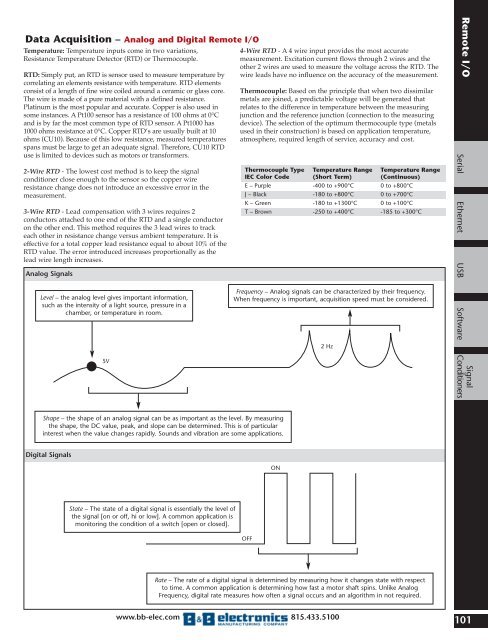

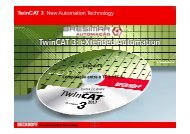

![BRESIMAR(asaTek)-Beckhoff-Livro Formação Técnica TwinCAT 2-v1.2_2009 [pt]](https://img.yumpu.com/62853104/1/190x245/bresimarasatek-beckhoff-livro-formacao-tecnica-twincat-2-v12-2009-pt.jpg?quality=85)


